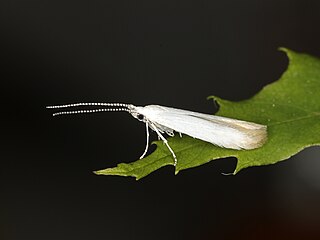
The chestnuts are the deciduous trees and shrubs in the genus Castanea, in the beech family Fagaceae. They are native to temperate regions of the Northern Hemisphere.

The American chestnut is a large, fast-growing deciduous tree of the beech family native to eastern North America. As is true of all species in genus Castanea, the American chestnut produces burred fruit with edible nuts. The American chestnut was one of the most important forest trees throughout its range.

The pathogenic fungus Cryphonectria parasitica is a member of the Ascomycota. This necrotrophic fungus is native to East Asia and South East Asia and was introduced into Europe and North America in the early 1900s. The fungus spread rapidly and caused significant tree loss in both regions.
Blight refers to a specific symptom affecting plants in response to infection by a pathogenic organism.

Castanea sativa, the sweet chestnut, Spanish chestnut or just chestnut, is a species of tree in the family Fagaceae, native to Southern Europe and Asia Minor, and widely cultivated throughout the temperate world. A substantial, long-lived deciduous tree, it produces an edible seed, the chestnut, which has been used in cooking since ancient times.

Phytophthora is a genus of plant-damaging oomycetes, whose member species are capable of causing enormous economic losses on crops worldwide, as well as environmental damage in natural ecosystems. The cell wall of Phytophthora is made up of cellulose. The genus was first described by Heinrich Anton de Bary in 1875. Approximately 210 species have been described, although 100–500 undiscovered Phytophthora species are estimated to exist.

Hevea brasiliensis, the Pará rubber tree, sharinga tree, seringueira, or most commonly, rubber tree or rubber plant, is a flowering plant belonging to the spurge family Euphorbiaceae originally native to the Amazon basin, but is now pantropical in distribution due to introductions. It is the most economically important member of the genus Hevea because the milky latex extracted from the tree is the primary source of natural rubber.

Castanea mollissima, also known as the Chinese chestnut, is a member of the family Fagaceae, and a species of chestnut native to China, Taiwan, and Korea.

Samuel Bowne Parsons Jr., was an American landscape architect. He is remembered as being a founder of the American Society of Landscape Architects, helping to establish the profession.

Mycoviruses, also known as mycophages, are viruses that infect fungi. The majority of mycoviruses have double-stranded RNA (dsRNA) genomes and isometric particles, but approximately 30% have positive-sense, single-stranded RNA (+ssRNA) genomes.

The chestnut casebearer moth is a species of moth in the family Coleophoridae. It is endemic to the United States, where it is found in Indiana, Massachusetts, Pennsylvania, and Virginia. It is a highly specialized species, its larvae feed specifically on the leaves of the American Chestnut. It was thought the species became extinct when many American chestnut trees died due to an infection of the fungus Cryphonectria parasitica, which was accidentally introduced from Asia around 1900. However, this species was rediscovered.

Diaporthales is an order of sac fungi.
Hypovirus is a genus of viruses, in the family Hypoviridae. Fungi serve as natural hosts. There are four species in this genus. Infection reduces the virulence of its parasitic host, making it a hyperparasite useful for blight control.
Forest pathology is the research of both biotic and abiotic maladies affecting the health of a forest ecosystem, primarily fungal pathogens and their insect vectors. It is a subfield of forestry and plant pathology.
Endothia is a genus of fungi within the family Cryphonectriaceae.

Dryocosmus kuriphilus is a species of gall wasp known by the common names chestnut gall wasp, Oriental chestnut gall wasp, and Asian chestnut gall wasp. It is native to China and it is known in many other parts of the world, particularly the Northern Hemisphere, as an introduced species and an invasive horticultural pest. It attacks many species of chestnut, including most cultivated varieties. It is considered the world's worst pest of chestnuts.
Rostraureum tropicale is a species of fungus from genus Rostraureum that is found in Ecuador.

A chestnut orchard is an open stand of grafted chestnut trees for fruit production. In this agroforestry system, trees are usually intercropped with cereals, hay or pasture. These orchards are traditional systems in Canton of Ticino (Switzerland) and Northern Italy, where they are called “selva castanile”. Similar systems can also be found in the Mediterranean region, for example, in France, Greece, Portugal or Spain.
Chestnut stuffing is a type of stuffing for roast goose and turkey dishes. Chestnut stuffing was more common in early American cuisine than it is in modern times. It could be prepared as a side for the typical meals of turkey or duck that were served at taverns. The American chestnut used for stuffing Thanksgiving turkeys used to be very common in the Eastern United States. Most of the trees were destroyed by the chestnut blight during the 20th century.













